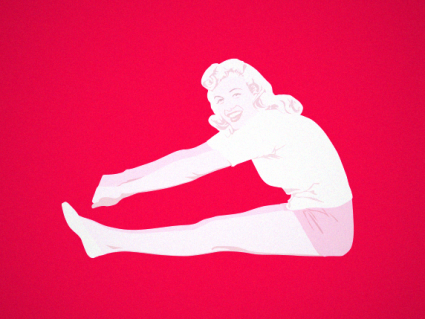The physical toll of knowledge work rarely comes in the form of a sudden injury. Instead any bodily damage from our nine to five is the result of tiny imperfections in our work habits building up over time — maybe we have bad posture when we email or inadvertently hold our breath when reading from our computer. If you spend an average of eight hours each day in front of a screen (and that’s not counting browsing in your free time), that’s well over 2,000 hours a year. While a little slouching now and then isn’t so bad, drawn out over thousands of hours our bad work habits can cause serious harm.
Lucky there’s a hack for our habits, that dates back to 500 BCE: yoga. Whether you’re a serial texter, seat slumper, or even a fan of the standing desk, these four yoga hacks will help heal the damage caused by any techno-centric, workaholic lifestyles. Through repetition these yoga practices will help prevent arthritis, reduce back pain, improve your posture, decrease stress, and leave you feeling more energized.
—
The Problem: After frequent texting and typing, your wrists feel stiff and sore.
Yoga Hack: Come to your hands and knees. Then, flip one wrist at a time, palms face down, with fingers pointing towards your knees. Start by making small circles over your wrists, shifting weight forwards and backwards. If this feels painful, keep working here and try adding a little more pressure each day. When you’re ready to move on, you can extend one leg back at a time, so that you’re in a plank pose (top of a push-up) with your wrists flipped. This will stretch out your wrist joints, while bringing new blood to the area, giving you more flexibility and range overtime, and helping to fight off arthritis.
The Problem: As your day draws to a close you find yourself slumping closer and closer to your screen, and by the time you log off you look more like Mr. Burns than your tall self.
Yoga Hack: Stand with feet hips width distance apart (if you’re not sure how wide this is, you can measure by placing two fists between your feet). Bend your knees as you fold forward, with the crown of your head dropping towards the ground. Clasp your palms behind your back and let them fall overhead. This is an intense shoulder stretch that will open up the front side of your body, counteracting any residual rounding from poor posture.
Problem: You work at a standing desk, but put all your weight on one hip at a time, or worse–you still find ways to slouch!
Yoga Hack: There’s a big difference between standing casually and standing up in yoga (also known as Mountain Pose). Start with your feet hips width distance apart, shift weight back into your heels, then into the balls of your feet, and rest somewhere in the middle so that you’re pressing all four corners of each foot into the ground (your feet should be so planted that you could withstand a gentle push without having to readjust).
Bend your knees and slowly straighten, mindfully stacking bone on top of bone. Roll your shoulders up to your ears and down the back. Puff up your chest, while tucking your chin slightly and gazing straight ahead (this will help stack your cervical spine on top of your thoracic spine, helping to eliminate back pain). Lastly, and most importantly, engage your thighs! You can do this by energetically drawing your legs upward, and flexing your adductor muscles. This will distribute your body weight evenly, so that the biggest muscles in your body (the muscles in your legs) can take weight off your joints, which will leave you feeling more energized, alert and symmetrical after standing for long periods at a time.
Problem: You take short, sharp breaths while completing stressful tasks, or worse, you hold your breath completely as a subconscious means of focusing.
Yoga Hack: Set a calendar reminder that goes off every three hours telling you to “breathe deeply.” When you see the alert start by exhaling all the air out of your lungs. Inhale fully through your nose (you should see your belly expand when you inhale), then slowly and evenly exhale, sending air from your belly through your chest, throat and finally nose, while lips are lightly sealed. Repeat as many times as you like. This controlled form of breathing (also known as Ujjayi breath) improves concentration while slowing down the nervous system, which negates any anxiety or stress we’re holding in the body. Pretty powerful stuff!

